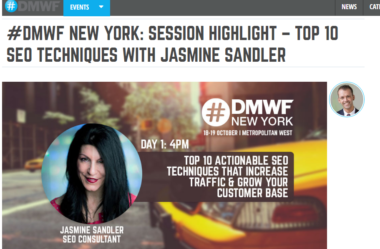There are literally hundreds of thousands of articles online about maximizing your conference/trade show attendance, but unfortunately, a lot of them offer generic advice, including “Don’t forget your business cards!”
I’m going to try to avoid that in this post by providing actionable steps.
I’m going to break this into two sections. The first is for organizations hosting an event. What do they need to be doing? The second is for individuals attending a conference. How do they maximize their participation? Ready? Let’s go.
Editor Note: SEJ has our own conference, SEJ Summit, taking place in 2017 at Chicago’s Navy Pier May 11. Get tickets today!
Conference Maximizing: For Organizations
I’ll do both of these in a checklist format to make it a bit easier to consume.
E-Mail Marketing

This is a little bit of a Goldilocks deal. You don’t want to email all your lists all the time about conferences because they will get annoyed and unsubscribe. I’d say 3-to-1 is the ratio early on. You do three emails about topics in your industry, and then one email about the conference. As it gets closer, or as early bird offers expire, up the ratio to 2-to-1. Regardless, use email as a tool — and use it with some frequency.
Social Media

This should go without saying, but I see it skipped often. Tag speakers. Come up with a hashtag for the conference and use it from the very early days of planning.
Personal Invites
Send personal (not automated!) LinkedIn, Twitter, and Google+ messages to people you think might benefit from attending your conference. Again, the key here (as DJ Khaled would say): personal, not automated.
Press Releases

Explain the value-add of the conference and highlight specific programs, attendees, and speakers. Get solid distribution on that.
Video Teasers
The human brain processes video about 60,000x faster than text. Make a quick, 1:00 video teaser and put it on YouTube and your Facebook page. Make it flashy and exciting. Quick cuts. The goal is to get fence-sitter attendees to decide to attend.
Blog

Publish a series of pre-event blog posts on your site. These should focus on the different speakers, the different tracks, what happened last year (if a recurring conference), major conference themes, etc. Each blog post should have a CTA to buy tickets.
Handout Materials
Essentially, giveaways and ways for attendees to engage with the conference.
Follow up with attendees: Look, let’s be honest. For organizations, conferences serve a lot of purposes — one is to showcase their products and services, of course. But another one is lead generation. So follow-up with attendees. Put the emails you capture in your funnel. Nurture these leads. Send them to your most profitable landing pages or to social networks where they can explore more about you and potentially working with you.
Conference Maximizing: Individuals
Again, checklist style.
Find the Speaker List

These are insanely easy to find. It’s usually a tab on the conference site called “Speakers.” Look at the speaker list. Do your homework. Make notes on the different speakers and what their focal area is. When you blog or social share, mention them — if that content is relevant to their niche. Engage beforehand.
Determine the Social Events

More happens at the happy hours and hotel bars in terms of one-to-one conversations to drive your business forward — as opposed to sitting in some huge conference hall listening to a person speak from 300 feet away. (That’s valuable, but not 1-on-1 valuable.) So make a list of the social events, and make sure you pack the right clothes for the vibe at each.
Check for a Conference App

For example, TED events have TEDConnect. Other conferences have specific, branded apps. Sometimes you can even get contact info of other attendees and LinkedIn profiles within the conference app. Learn it, use it, embrace it.
Do Your Pre-Work
This is very important and needs to take up some time. It is time well invested. Here’s what you need to do:
Look at your speaker list (above):
- Determine their focal areas
- Blog/design tweets and LinkedIn shares around those areas
- Engage with the speakers
- If you get re-engagement, consider a quick message to them about meeting up
Next: monitor the conference hashtag:
- See who’s attending and using the hashtag before the conference
- Research these people
- Make a list of “should meet” and “would be nice to meet” and “not interested.”
- Start with your “should meet” list
- Research, research, research
- Engage in the same way you did with the speaker list
- After a few rounds of this, you should have a list of several people to engage with in person
- Send follow-up messages 2-3 days before reminding them of the connection and proposing coffee/drink/etc.
At Conference Work
The pre-work is essential because it sets up the meetings and appointments that will drive the value for you. If you spend $1,500 to attend a conference, it’s awesome if you get great ideas from it — but those ideas may never necessarily become $1,501 (which would mean you got a return on the attendance). So now with the pre-work, you’ve hooked the people you want to connect with. If your pre-work tanks (that sometimes happens), make a visual note of who’s who and a one-sentence approach line, like “I loved your blog on digital marketing strategy from last month.” Then start the conversation. (And remember: conversations at these things should be about 80 percent listening.)
As soon as the conversation is over, pull out your smartphone, open a Notes tab, write the person’s name, and three key points of the conversation – possible collaborations you discussed, needs they expressed, or facts about themselves they shared. Keep doing this on the same Notes tab with every person you talk to. Now you have a smartphone record of the important aspects of every conversation you had.
Post Conference Works
Using that smartphone record, follow-up with everyone. If you’re messaging on an app or within social media, get their email address. Add their information to whatever CRM or tracking device you use, be it Salesforce or LinkedIn Sales Navigator. Begin to nurture. And as you do this? Get ready for that next conference!
Preparing for and maximizing your effectiveness at business conferences can lead to brand visibility, increase in market share, and new business development. Use these steps to maximize your opportunities.
Screenshots were taken Oct 2016.
Featured Image via DepositPhotos





![AI Overviews: We Reverse-Engineered Them So You Don't Have To [+ What You Need To Do Next]](https://www.searchenginejournal.com/wp-content/uploads/2025/04/sidebar1x-455.png)